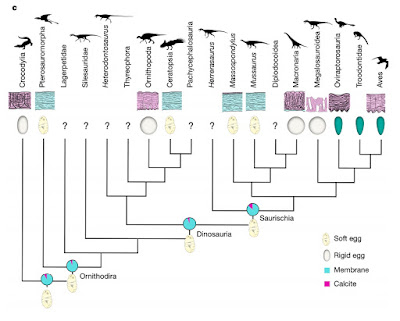 |
| Mussaurus patagonicus Bonaparte & Vince, 1979 in Norell, Wiemann, Fabbri, et al., 2020. Illustration: Jorge González |
new & recent described Flora & Fauna species from all over the World esp. Asia, Oriental, Indomalayan & Malesiana region
Monday, November 30, 2020
[Paleontology • 2020] The First Dinosaur Egg was Soft
[Botany • 2020] Acianthera villahermosae (Orchidaceae, Pleurothallidinae) • A New Species of Acianthera from the Cordillera Central of Colombia
 |
| Acianthera villahermosae Sierra-Ariza, Rinc.-González & Karremans in Rincón-González, Sierra-Ariza & Karremans, 2020. |

[Entomology • 2020] The New World Ant Parasitoid Genus Orasema (Hymenoptera: Eucharitidae)
 |
| Orasema sp. in Baker & Heraty, 2020. |
Sunday, November 29, 2020
[Entomology • 2020] New Species and New Record of Cavernicolous Ground Beetles (Coleoptera: Carabidae: Pterostichini and Platynini) from Sichuan Province, China
[Ichthyology • 2020] Indoreonectes telanganaensis • A New Species of Loach (Teleostei: Nemacheilidae) from the Godavari Basin of India
 |
| Indoreonectes telanganaensis Prasad, C. Srinivasulu, A. Srinivasulu, Anoop & Dahanukar, 2020 |
[Crustacea • 2020] Why do Shrimps leave the Water? Mechanisms and Functions of Parading Behaviour in Freshwater Shrimps
 |
| Macrobrachium dienbienphuense Dang & Nguyen, 1972 Parading shrimps synchronously walking on land at night at the Lamduan Rapids, Ubon Ratchathani, Thailand. in Hongjamrassilp, Maiphrom et Blumstein, 2020. DOI: 10.1111/jzo.12841 Photos: Watcharapong Hongjamrassilp |
 |
| Parading shrimps synchronously walking on land at night at the Lamduan Rapids, Ubon Ratchathani, Thailand. Photo: Watcharapong Hongjamrassilp. |
[Botany • 2020] Typhonium sagaingense (Araceae) • A New Areae Species from Sagaing Region [Taxonomic Studies of Araceae in Myanmar I]
[Entomology • 2021] Eucorydia donanensis & E. tokaraensis • Two New Species of the Genus Eucorydia (Blattodea: Corydiidae) from the Nansei Islands in Southwest Japan
 |
| Eucorydia sp. Yanagisawa, Hiruta, Sakamaki, Liao & Shimano, 2021 DOI: 10.2108/zs200048 |
[Crustacea • 2020] Species of the Maera-clade (Amphipoda: Maeridae) collected from Japan. Part 4: Addenda to Genera Maera Leach, 1814 and Quadrimaera Krapp-Schickel & Ruffo, 2000, with Revised Keys to Japanese Species of the Clade
 |
| Maera denticoxa Ariyama, Kodama & Tomikawa, 2020 |
[Herpetology • 2020] Rhinophis karinthandani • A New Indian Species of Rhinophis Hemprich, 1820 closely related to R. sanguineus Beddome, 1863 (Serpentes: Uropeltidae) from the Western Ghats of peninsular India
 |
| Rhinophis karinthandani Sampaio, Narayanan, Cyriac, Venu & Gower, 2020 |
[Mammalogy • 2020] Back to Life and to Taxonomy: New Record and Reassessment of Myotis bucharensis (Chiroptera: Vespertilionidae)
 |
| Myotis bucharensis Kuzyakin, 1950 in Kazakov, Artyushin, Khabilov, et al., 2020. |
[Herpetology • 2020] Cnemaspis ranganaensis • A New Cnemaspis Strauch, 1887 (Squamata: Gekkonidae) from the northern Western Ghats, Maharashtra, India
 |
| Cnemaspis ranganaensis Sayyed & Sulakhe, 2020 |
Abstract
A new species belonging to the genus Cnemaspis Strauch, 1887 is described from the Rangana Fort mountain range of the northern Western Ghats, Maharashtra, India. A preliminary 16S rRNA phylogeny of Indian Cnemaspis is provided and the phylogenetic position of the new species is established within the goaensis clade. The new species, Cnemaspis ranganaensis sp. nov. can easily be distinguished from all Indian congeners by having 3 or 4 spine-like tubercles on the flanks, conical tubercles absent on flank, dorsal pholidosis heterogeneous, presence of precloacal and femoral pores in males, 8 or 9 poreless scales between femoral and precloacal pores; gular scales flat, smooth; 93–101 paravertebral scales, 59–63 mid-dorsal scales; 93–101 longitudinal scales from mental to cloaca, 30–31 scales across belly; ventral scales smooth, imbricate; tail with small, granular, keeled, pointed, subimbricate scales intermixed with enlarged, strongly keeled, conical tubercles forming whorls; scales on ventral side of tail imbricate, smooth, with three rows of large, slightly elongated median subcaudals. The new species is closely related to C. goaensis, from which it differs by a genetic divergence of 1.9-3.0%. Molecular phylogenetic reconstruction supports the distinctiveness of the new species.

Saturday, November 28, 2020
[Entomology • 2020] The Cicadas (Hemiptera: Cicadidae) of Ecuador including the Description of Five New Species, A New Subtribe, Four New Synonymies, and Fifteen New Records
 |
| Calyria xiphion Sanborn, 2020 |


































